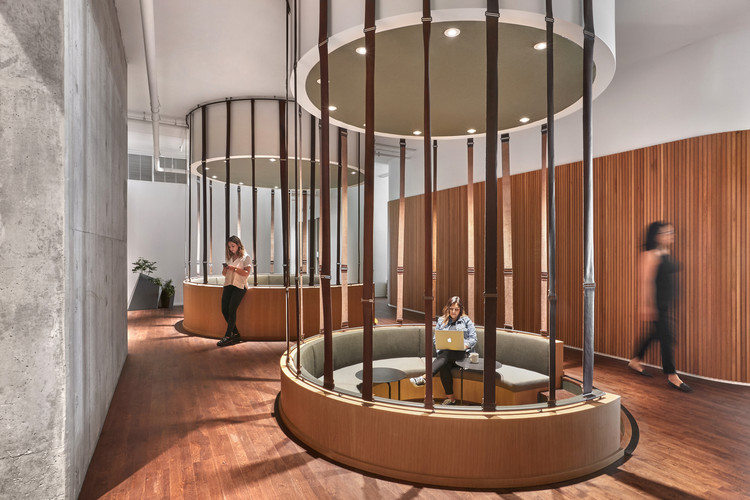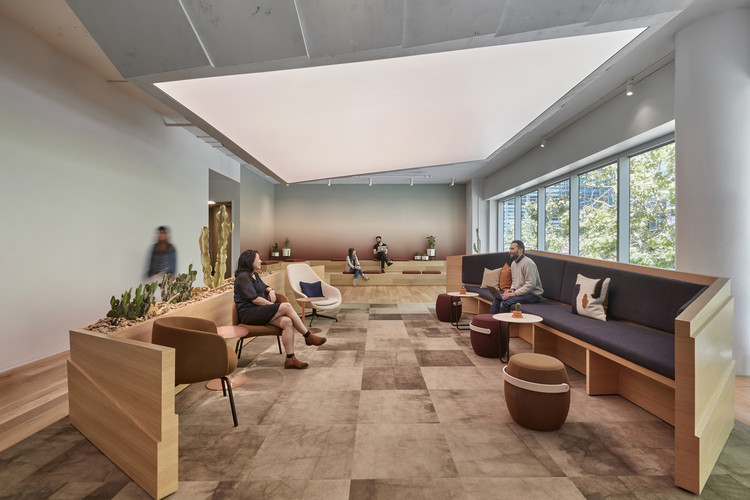
The COVID-19 pandemic has reshaped how we work together. From telecommuting to virtual programming, architects and designers are rethinking traditional office structures to reimagine collaboration around the world. For architect Evelyn Lee, her work as the first Senior Experience Designer at Slack Technologies centers on building better workplace experiences. In a year defined by remote work, she's exploring what culture and community mean today.

Why did you choose to study architecture, and later, a MPA/MBA?
I was one of those kids that knew from a very young age that I wanted to become an architect. It was in the 4th grade when we had an assignment to draw our dream homes. Most kids drew a front elevation, I did a plan and specifically remember putting a TV and the original Nintendo gaming system in each room (priorities).
The reason I originally pursued a MBA was in part because I hit a point in my life where I didn’t know what steps I wanted to take next in my career. It was strange having a clear path from such a young age, reaching your goal, and realizing that it may not be the right career for you.
I took an active break from everything architecture in my first year getting my MBA, making a real attempt to check out other industries. I avoided any of the clubs related to building and sustainable development and tried marketing, entertainment, consulting, etc.

What I learned is that I really missed being connected to the building industry and realized that I would eventually have to find my way back. The MPA I picked-up because the MBA is so much more quantitative and MPA is a way to look at organizations qualitatively.
What was originally supposed to be a 2-year detour ultimately turned into a 4-year journey.
ArchDaily’s monthly topic is “How Will We Live Together?”, taking inspiration from the (now rescheduled) Venice Biennale theme. Extending this question to work, how do you think the workplace will change for architects and designers in the future?
I think there will be greater care taken in opportunities when we have the ability to come together again in teams. I think that the pandemic has created a lot of immediate change, but I can’t ever see a time where people no longer come together as a community.

I have actually been really inspired by leaders in my company, in the profession, and more broadly on a very public stage that has been open to being vulnerable during this time. They are not only incredible storytellers and communicators, but it really helps us establish the notion that we are not going through this alone in this.
What’s more, is that this pandemic is a shared global experience. It has been incredible to see how communities are not only coming together across the nation but globally to help one another through this.

I think rhetorically the response is that we are very much living this shared reality together, I just hope that the flow of information and empathy continue well after COVID is a distant memory.
You have a diverse background with a range of experiences rooted in design. What does your role at Slack encompass, and what are some recent projects you’ve been working on?
I’m helping lead a conversation around the future of our offices, and also actively a part of planning what the return to office looks like. I am working on a number of projects at any given time, but really most of them help us be strategic about re-entry and the future.

With changes to climate, technology, and construction, how do you think architects and designers will adapt ways of practicing to advance the profession?
I’ve been active enough in the profession to not get my hopes up when it comes to advancing the profession. I have been known to open-up conversations by saying we are three recessions away from becoming extinct.
While some people agree with me (and many more often raise in eyebrow), it’s really meant as a conversation starter and a statement to the lack of agility that has persisted in our profession for decades.
At a very minimum, I hope that the profession takes note of all the things that have created positive shifts during the pandemic and find a way to integrate it into practice going forward.

I also think this is a good opportunity to seek out new service lines. Architects always talk about being the trusted advisor for their clients, but if you can only serve them when they need something architecturally, you’ll be hard-pressed to get them to pick-up the phone and call you to talk about something more strategic.
Inevitably there will be firms that adapt or change and even those who come directly out of school with a new and different approach to how we have been doing things for decades. Those who remain agile will continue to thrive and expand the value of the architect.

Changes due to COVID-19 have been swift. How do you think the pandemic will shape design?
At the city scale, I’m really interested in how the changing nature of how companies are working is going to shift the fabric of larger urban centers. There has been some interesting conversations around converting offices to housing, but I think it will be a while before it all really plays out.
I think that there will be design decisions at the building level, taking into consideration the short and longer behavior changes that may come out of COVID. The ability to move through buildings without touching any surfaces (be it calling an elevator or opening doors).
I also think that there will be those who remain ever vigilant informing broader design strategies within various different market verticles. How, for instance, does the design of hospitals evolve keeping in mind that this may very well not be the only pandemic that many of us live through.

As you look to the future, are there any ideas you think should be front and center in the minds of architects and designers?
In addition to the changes COVID 19 has placed on our businesses, and digital natives become an increasingly higher percentage of the workforce. If this pandemic does not fundamentally change the way you build a culture within your firm, pursue new business, and make you question what other value you can bring to current and potential clients - you will have a very long road ahead of you.
The more adaptable and agile you can continue to remain within an ever-changing environment, the greater your chance for success in the long term.
This article is part of the ArchDaily Topic: How Will We Live Together. Every month we explore a topic in-depth through articles, interviews, news, and projects. Learn more about our monthly topics here. As always, at ArchDaily we welcome the contributions of our readers; if you want to submit an article or project, contact us.







